介词加关系代词导学案
- 格式:doc
- 大小:52.51 KB
- 文档页数:4
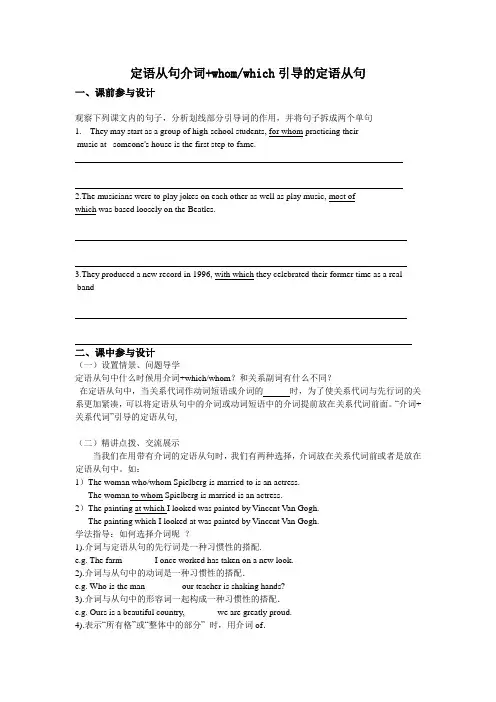
定语从句介词+whom/which引导的定语从句一、课前参与设计观察下列课文内的句子,分析划线部分引导词的作用,并将句子拆成两个单句1.They may start as a group of high-school students, for whom practicing theirmusic at someone's house is the first step to fame.2.The musicians were to play jokes on each other as well as play music, most ofwhich was based loosely on the Beatles.3.They produced a new record in 1996, with which they celebrated their former time as a realband二、课中参与设计(一)设置情景、问题导学定语从句中什么时候用介词+which/whom?和关系副词有什么不同?在定语从句中,当关系代词作动词短语或介词的时,为了使关系代词与先行词的关系更加紧凑,可以将定语从句中的介词或动词短语中的介词提前放在关系代词前面。
“介词+关系代词”引导的定语从句,(二)精讲点拨、交流展示当我们在用带有介词的定语从句时,我们有两种选择,介词放在关系代词前或者是放在定语从句中。
如:1)The woman who/whom Spielberg is married to is an actress.The woman to whom Spielberg is married is an actress.2)The painting at which I looked was painted by Vincent Van Gogh.The painting which I looked at was painted by Vincent Van Gogh.学法指导:如何选择介词呢?1).介词与定语从句的先行词是一种习惯性的搭配.e.g. The farm _______I once worked has taken on a new look.2).介词与从句中的动词是一种习惯性的搭配.e.g. Who is the man ________our teacher is shaking hands?3).介词与从句中的形容词一起构成一种习惯性的搭配.e.g. Ours is a beautiful country, _______we are greatly proud.4).表示“所有格”或“整体中的部分” 时,用介词of.e.g. There are over one thousand workers in the factory, 80 percent ________ are women.(三)迁移应用、巩固训练一.将下面的两个简单句合并成一个含有定语从句的复合句。
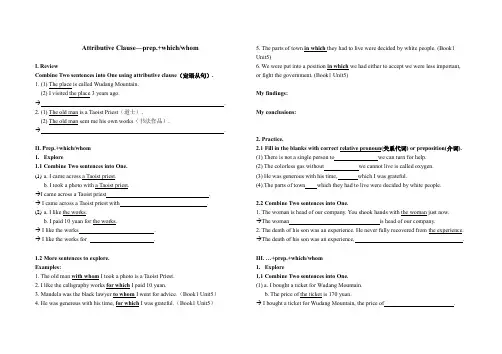
Attributive Clause—prep.+which/whomI. ReviewCombine Two sentences into One using attributive clause(定语从句).1. (1) The place is called Wudang Mountain.(2) I visited the place 3 years ago.→.2. (1) The old man is a Taoist Priest(道士).(2) The old man sent me his own works(书法作品).→.II. Prep.+which/whom1.Explore1.1 Combine Two sentences into One.(1)a. I came across a Taoist priest.b. I took a photo with a Taoist priest.→I came across a Taoist priest .→ I came across a Taoist priest with .(2)a. I like the works.b. I paid 10 yuan for the works.→ I like the works .→ I like the works for .1.2 More sentences to explore.Examples:1. The old man with whom I took a photo is a Taoist Priest.2. I like the calligraphy works for which I paid 10 yuan.3. Mandela was the black lawyer to whom I went for advice.(Book1 Unit5)4. He was generous with his time, for which I was grateful.(Book1 Unit5)5. The parts of town in which they had to live were decided by white people. (Book1 Unit5)6. We were put into a position in which we had either to accept we were less important, or fight the government. (Book1 Unit5)My findings:My conclusions:2. Practice.2.1 Fill in the blanks with correct relative pronoun(关系代词) or preposition(介词).(1) There is not a single person to we can turn for help.(2) The colorless gas without we cannot live is called oxygen.(3) He was generous with his time, which I was grateful.(4) The parts of town which they had to live were decided by white people.2.2 Combine Two sentences into One.1. The woman is head of our company. You shook hands with the woman just now.→The woman is head of our company.2. The death of his son was an experience. He never fully recovered from the experience.→The death of his son was an experience, .III. …+prep.+which/whom1.Explore1.1 Combine Two sentences into One.(1) a. I bought a ticket for Wudang Mountain.b. The price of the ticket is 170 yuan.→ I bought a ticket for Wudang Mountain, the price of .(2) a. Many visitors were attracted to Wudang Mountain.b. The top of Wudang Mountain is called Jinding.→ Many visitors were attracted to Wudang Mountain, .(3)a. Many foreign tourists visited Wudang Mountain.b. Some of the foreigners even learned to play Tai Chi.→ Many foreign tourists visited Wudang Mountain, even learned to play Tai Chi.1.2 Comparisons1. The old man with whom I took a photo is a Taoist Priest.2. I like the calligraphy works for which I paid 10 yuan.3. I bought a ticket for Wudang Mountain, the price of which is 170 yuan.4. Many visitors were attracted to Wudang, the top of which is called Jinding.5. Many tourists visited Wudang Mountain, some of whom were from foreign countries. My Findings:My Conclusions:2.Practice.2.1 Make the following TWO sentences into ONE.(1) a. I saw a house.b. The windows of the house were broken.→.(2) a. There are sixty students in our class.b. Thirty of the students in our class are girls.→.2.2 Translations 1. 每年,许多游客(visitor)来到武当山,其中一些来自国外(from abroad)。
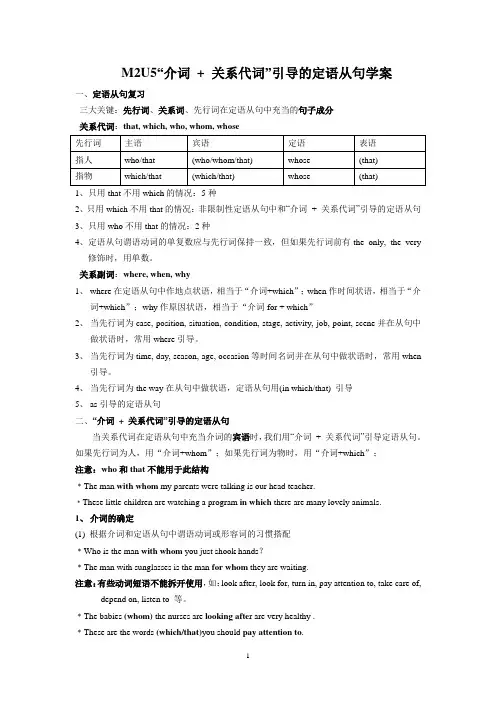
M2U5“介词+ 关系代词”引导的定语从句学案一、定语从句复习三大关键:先行词、关系词、先行词在定语从句中充当的句子成分关系代词:that, which, who, whom, whose1、只用that不用which的情况:5种2、只用which不用that的情况:非限制性定语从句中和“介词+ 关系代词”引导的定语从句3、只用who不用that的情况:2种4、定语从句谓语动词的单复数应与先行词保持一致,但如果先行词前有the only, the very修饰时,用单数。
关系副词:where, when, why1、where在定语从句中作地点状语,相当于“介词+which”;when作时间状语,相当于“介词+which”;why作原因状语,相当于“介词for + which”2、当先行词为case, position, situation, condition, stage, activity, job, point, scene并在从句中做状语时,常用where引导。
3、当先行词为time, day, season, age, occasion等时间名词并在从句中做状语时,常用when引导。
4、当先行词为the way在从句中做状语,定语从句用(in which/that) 引导5、as引导的定语从句二、“介词+ 关系代词”引导的定语从句当关系代词在定语从句中充当介词的宾语时,我们用“介词+ 关系代词”引导定语从句。
如果先行词为人,用“介词+whom”;如果先行词为物时,用“介词+which”;注意:who和that不能用于此结构﹡The man with whom my parents were talking is our head teacher.﹡These little children are watching a program in which there are many lovely animals.1、介词的确定(1) 根据介词和定语从句中谓语动词或形容词的习惯搭配﹡Who is the man with whom you just shook hands?﹡The man with sunglasses is the man for whom they are waiting.注意:有些动词短语不能拆开使用,如:look after, look for, turn in, pay attention to, take care of, depend on, listen to 等。
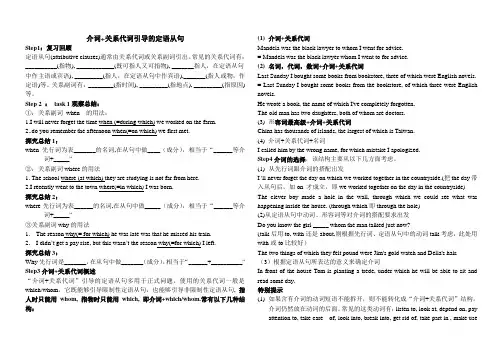
介词+关系代词引导的定语从句Step1:复习回顾定语从句(attributive clauses)通常由关系代词或关系副词引出。
常见的关系代词有:__________(指物), ____________(既可指人又可指物), _______指人,在定语从句中作主语或宾语), _________(指人,在定语从句中作宾语),_______(指人或物,作定语)等。
关系副词有:________(指时间), _________(指地点), _________(指原因)等。
Step 2 :task 1观察总结:①:关系副词when 的用法:1.I will never forget the time when (=during which) we worked on the farm.2..do you remember the afternoon when(=on which) we first met.探究总结1:when 先行词为表_______的名词,在从句中做____(成分),相当于“______等介词+_____”②:关系副词where的用法1. The school where (at which) they are studying is not far from here.2.I recently went to the town where(=in which) I was born.探究总结2:where先行词为表______的名词,在从句中做_____(成分),相当于“______等介词+_____”③关系副词why的用法1.The reason why(= for which) he was late was that he missed his train.2.I didn’t get a pay rise, but this wasn’t the reason why(=for which) I left.探究总结3:Why先行词是_______,在从句中做_______(成分),相当于“______+__________”Step3介词+关系代词概述“介词+关系代词”引导的定语从句多用于正式问题,使用的关系代词一般是which/whom,它既能够引导限制性定语从句,也能够引导非限制性定语从句, 指人时只能用whom, 指物时只能用which, 即介词+which/whom.常有以下几种结构:(1)介词+关系代词Mandela was the black lawyer to whom I went for advice.= Mandela was the black lawyer whom I went to for advice.(2)名词,代词,数词+介词+关系代词Last Sunday I bought some books from bookstore, three of which were English novels. = Last Sunday I bought some books from the bookstore, of which three were English novels.He wrote a book, the name of which I've completely forgotten.The old man has two daughters, both of whom are doctors.(3)形容词最高级+介词+关系代词China has thousands of islands, the largest of which is Taiwan.(4) 介词+关系代词+名词I called him by the wrong name, for which mistake I apologized.Step4介词的选择,该结构主要从以下几方面考虑。
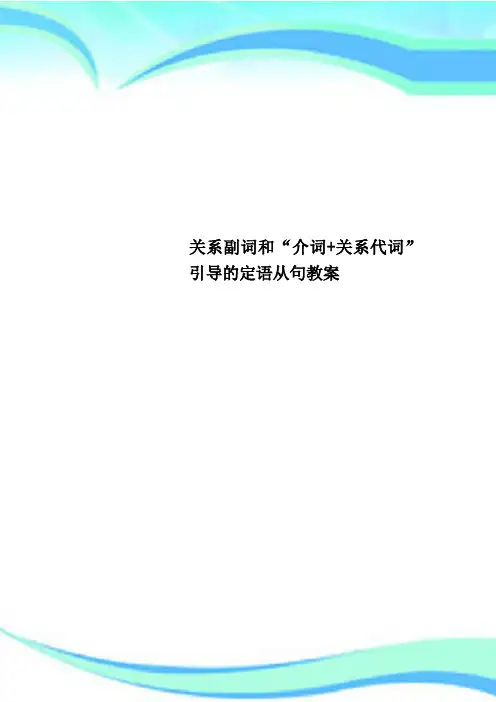
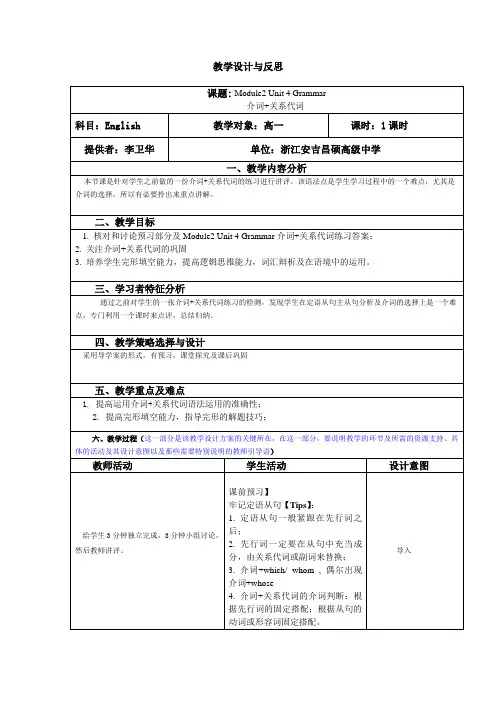
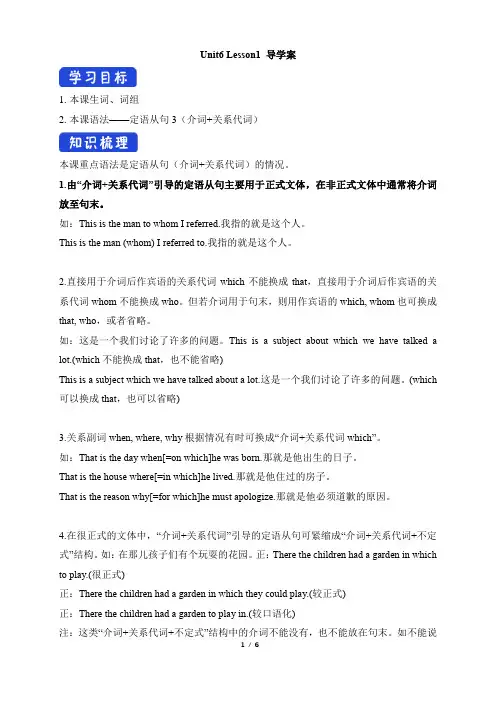
Unit6 Lesson1 导学案1.本课生词、词组2.本课语法——定语从句3(介词+关系代词)本课重点语法是定语从句(介词+关系代词)的情况。
1.由“介词+关系代词”引导的定语从句主要用于正式文体,在非正式文体中通常将介词放至句末。
如:This is the man to whom I referred.我指的就是这个人。
This is the man (whom) I referred to.我指的就是这个人。
2.直接用于介词后作宾语的关系代词which不能换成that,直接用于介词后作宾语的关系代词whom不能换成who。
但若介词用于句末,则用作宾语的which, whom也可换成that, who,或者省略。
如:这是一个我们讨论了许多的问题。
This is a subject about which we have talked a lot.(which不能换成that,也不能省略)This is a subject which we have talked about a lot.这是一个我们讨论了许多的问题。
(which 可以换成that,也可以省略)3.关系副词when, where, why根据情况有时可换成“介词+关系代词which”。
如:That is the day when[=on which]he was born.那就是他出生的日子。
That is the house where[=in which]he lived.那就是他住过的房子。
That is the reason why[=for which]he must apologize.那就是他必须道歉的原因。
4.在很正式的文体中,“介词+关系代词”引导的定语从句可紧缩成“介词+关系代词+不定式”结构。
如:在那儿孩子们有个玩耍的花园。
正:There the children had a garden in which to play.(很正式)正:There the children had a garden in which they could play.(较正式)正:There the children had a garden to play in.(较口语化)注:这类“介词+关系代词+不定式”结构中的介词不能没有,也不能放在句末。
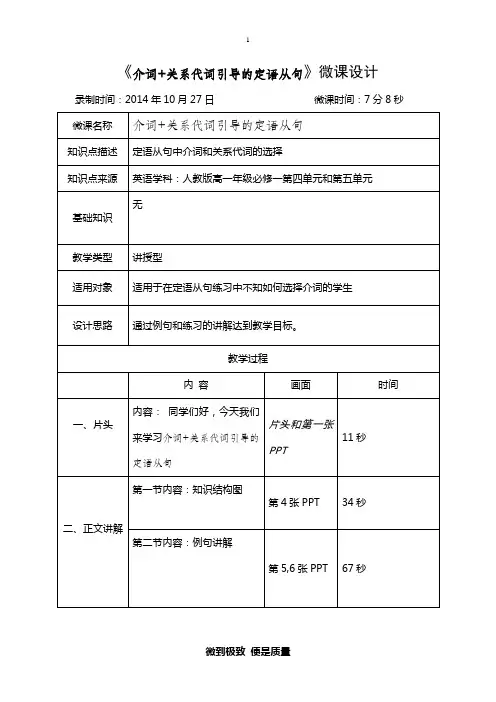
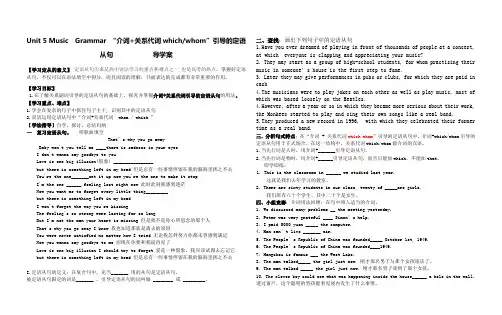
Unit 5 Music Grammar “介词+关系代词which/whom”引导的定语从句导学案【学习定从的意义】定语从句历来是高中语法学习的重点和难点之一,也是高考的热点。
掌握好定语从句,不仅可以在语法填空中得分,而且阅读的理解,书面表达的完成都有非常重要的作用。
【学习目标】1.在了解关系副词引导的定语从句的基础上,探究并掌握介词+关系代词引导的定语从句的用法。
【学习重点、难点】1.学会在复杂的句子中抓住句子主干, 识别其中的定语从句2.灵活运用定语从句中“介词+关系代词 whom / which ”【学法指导】自学,探讨,总结归纳一复习定语从句。
听歌曲填空That’s why you go awayBaby won't you tell me ____there is sadness in your eyesI don't wanna say goodbye to youLove is one big illusion(假象) ________________but there is something left in my head 但是总有一些事情停留在我的脑海里挥之不去You're the one_______set it up now you're the one to make it stopI'm the one ______ feeling lost right now 此时此刻我感到迷茫Now you want me to forget every little thing_________but there is something left in my headI won't forget the way you're kissingThe feeling's so strong were lasting for so longBut I'm not the man your heart is missing 但是我不是你心所思念的那个人That's why you go away I know 我也知道那就是离去的原因You were never satisfied no matter how I tried 无论我怎样努力你都未曾感到满足Now you wanna say goodbye to me 而现在你要和我说再见了Love is one big illusion I should try to forget 爱是一种假象,我应该试图去忘记它but there is something left in my head 但是总有一些事情停留在我的脑海里挥之不去I.定语从句的定义:在复合句中,充当_______ 用的从句是定语从句,被定语从句限定的词是_______ ,引导定语从句的词叫做 ________ 或 _________。
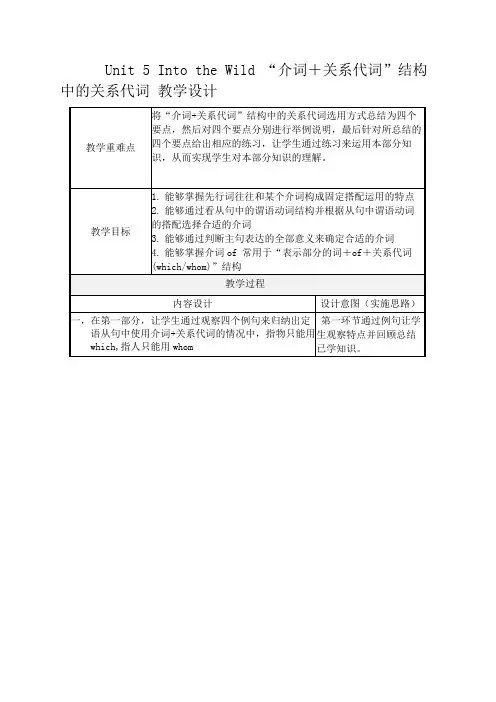
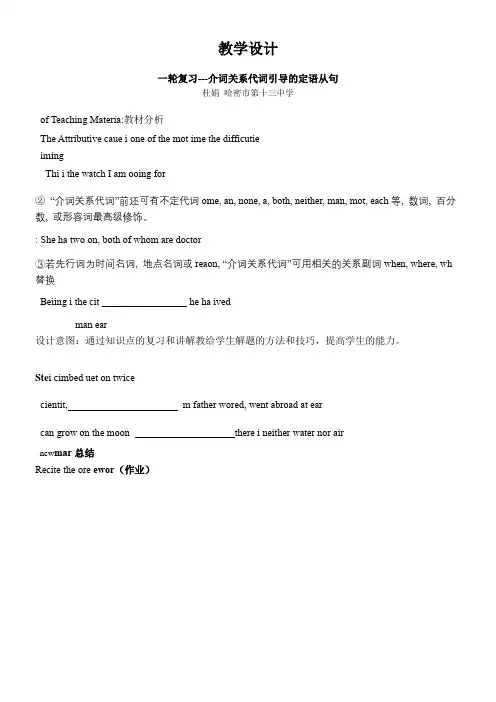
教学设计一轮复习---介词关系代词引导的定语从句杜娟哈密市第十三中学of Teaching Materia:教材分析The Attributive caue i one of the mot ime the difficutieim ingThi i the watch I am ooing for②“介词关系代词”前还可有不定代词ome, an, none, a, both, neither, man, mot, each等, 数词, 百分数, 或形容词最高级修饰。
: She ha two on, both of whom are doctor③若先行词为时间名词, 地点名词或reaon, “介词关系代词”可用相关的关系副词when, where, wh 替换Beiing i the cit _________________he ha ivedman ear设计意图:通过知识点的复习和讲解教给学生解题的方法和技巧,提高学生的能力。
Ste i cimbed uet on twicecientit, m father wored, went abroad at earcan grow on the moon there i neither water nor airnew mar总结Recite the ore ewor(作业)the e VIII Refection反思利用讲解、引导学生思考、讨论、练习等教学手段来帮助学生学习介词关系代词引导的定语从句。
在这个过程中,教师层层深入,引导学生掌握定语从句的相关知识点,并教会学生解题的方法和技巧。
总的来说,达到了预期的目标。
介词+关系代词引导的定语从句【学习目标】借助自己的资料书、周报和语法书探究介词+关系代词引导的定语从句的用法。
【学习重点、难点】介词+关系代词引导的定语从句中“介词”的选用。
1 自主学习1.1 A组:用关系代词填空。
指出1-2题和3-4题的规律。
1. He likes the birthday gifts ____________ his friends gave him.2. The girl ______________ you have just seen is very good at English.3. Daniel is the person ______________ I want to make friends with.4. The subject ____________ Eric is interested in is Physics.1.2 B 组:比较下列句子, 得出规律。
1. This is the house which I used to live in.2. This is the house in which I used to live.3 The man whom they are talking about is my father.4 The man about whom they are talking is my father.2 介词+关系代词引导的定语从句中“关系代词”的选用2.1 关系代词在定语从句中做介词宾语时,从句常由_________+关系代词引导(1) Tomorrow I will bring here a magazine (that/which) you askedfor.换:Tomorrow I will bring here a magazine ______ _________ you asked.(2) We’ll go to hear the famous singer (whom/that/who) we haveoften talked about.换:We’ll go to hear the famous singer ________________ we have often talked.2.2. 注意:若介词放在关系代词前,关系代词指人时用________,不能用_______;指物时用_________,不能用_________.判断下面两组翻译哪句是对的?1(1) The man with whom you talked is my friend. ( )(2) The man with that you talked is my friend. ( )(3) The plane in which we flew to Canada is very comfortable. ( )(4) The plane in that we flew in to Canada is very comfortable. ( )3 如何选用介词?情况1 介词选用的基本原则1.1.根据从句的谓语动词确定介词This is the village ______ _______ we often go.This is the book _______ _______ you asked.1.2. 根据从句中的形容词短语来确定介词The tw o subjects ______ _______ I’m interested are English and maths.The snake ______ _______ she used to be afraid is her favorite animal now.These are some books ________ ________I am not very familiar.1.3. 根据从句所修饰的先行词来确定介词:1. Do you remember the day ______ ________ we met for the first time?2. The pencil ______ ________ he was writing broke.3. I don’t like the way _______ ___________ he talks.注意:1当先行词是way时,做状语时,关系代词可用_________ ___________________.e.g. This is the way____________________________ he memorizes English words.情况2 含有介词的动词短语一般不拆开使用,如:look for, look after, take care of 等。
定语从句(3)Attributive clause“介词+关系代词”引导的定语从句定语从句(3)Attributive clause“介词+关系代词”引导的定语从句Part 1: The analysis of the teaching material and students Generally speaking, grammar is a real headache for most of students for it is very boring and difficult. Attributive clause is the most important and the most difficult grammar in English. In order to let students master it easily, I will ask students to do more exercises. After all, practice makes perfect.本节课是中等职业教育新教材基础模块三第6单元和第7单元语法内容——定语从句的拓展。
在教材第6单元和第7单元中,主要讲解了引导定语从句的关系代词和关系副词,对“介词+关系代词”引导的定语从句却未涉及,但在教材配套练习册中,这一部分的内容却是经常出现,必须掌握。
基于这一点,我们将本部分的内容作为重点知识进行补充讲解。
但总的来说,枯燥的语法使大部分学生感到头疼,产生惧怕心里,从而失去学习的积极性。
为了帮助学生掌握这部分的知识,克服学习的障碍,我在教学过程中由易入难,层层深入,运用启发式教学帮助同学更好的掌握这部分教学内容。
Part 2: Teaching aimsKnowledge aims:Help students learn to use “whom / which” in attributive clause that contain prep.+ whom / whichAbility aims:Help students learn to choose the prepositions in attributive clauses that contain prep.+ whom / whichEmotional aims:Encourage students to study hard and overcome the difficulties in learning EnglishPart 3: Teaching important and difficult pointsHow to help the students to use what they’ve learned to solve the attributive clause questions.Part 4: Teaching methods and aidsTeaching methods: 1. Asking-and-answering activity2. Task-based teaching and learningTeaching aids: seewo5交互式一体机Part 5: Teaching proceduresStep 1. Revision and Lead in1.概念:在复合句中,修饰名词(或代词)的句子叫定语从句。
定语从句导学案(2)关系副词教学目标:1.学习关系副词引导的限制性定语从句。
2.学习“介词+关系代词”引导的定语从句。
3.通过讲练,使学生掌握关系副词引导的限制性定语从句和“介词+关系代词”引导的定语从句。
学习重点:关系副词引导的限制性定语从句和“介词+关系代词”引导的定语从句。
学习难点:介词的选择和关系词的选择。
Teaching ProceduresStep 1 Lead inStep 1 RevisionTranslate some sentences into English.1.This is the man who helped me.2.The Doctor whom you are looking for is in the room.3.Do you know the man whose name is Yao Ming?4.I have lost my book, which I like very much.5.He sold his bicycle, which surprised me.6.As is known to all, China is a country with the largest population inthe world.Step 3 Grammar Learning---Explanations一、关系副词的基本用法:当先行词表示时间、地点、原因,且这些先行词在定语从句中作状语时,就分别用when, where, why来引导定语从句。
when, where, when=in, at, on, during等+which;where=in, at, on, under等+which;why一般可用“介词+which”替代。
如:I still remember the day (=on which) when I first came to our school. Xi’an is the city where (=in which) I was born.Can you tell me the reason why (=for which) he is absent?注意:1、先行词是表示时间、地点或原因的,但它们在定语从句中不是作状语,而是作主语、宾语或定语时,也不能用关系副词(when, where, why),而要用关系代词。